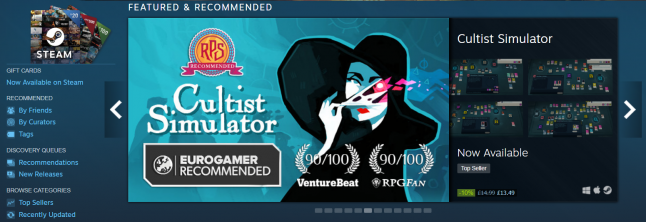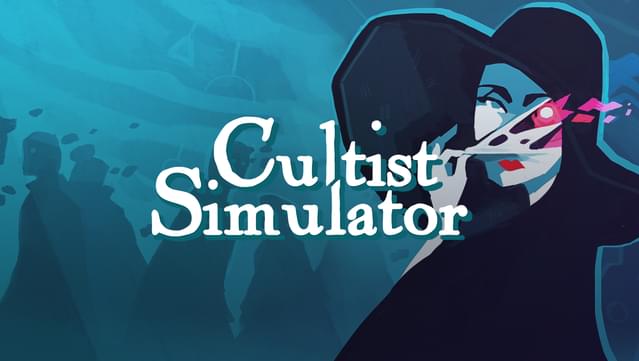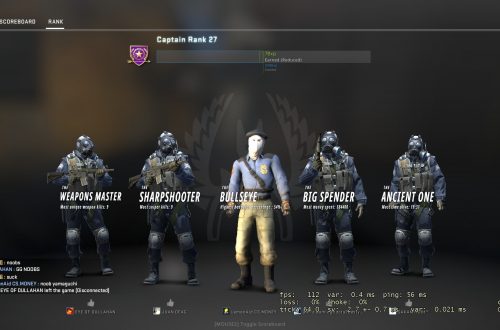I talked at Develop this year about open production, a system of developing games in the full sight of your community and building your audience as you go. It reminded me that I hadn’t shared the Cultist Simulator retrospective as widely as I should have, and that the successes (and mistakes!) might be useful to indies who haven’t read it yet. So, here we are! Gama, spread this cautionary tale.
It’s worth mentioning that there are lots of things – both good and bad – which don’t get a look-in, because they’re not the headline points. We’re absolutely delighted by Maribeth Solomon’s work on the soundtrack, for example, and I’m very proud we didn’t move project goalposts even when we were tempted. But I don’t want to get stuck trying to tell you everything: below are the top-line woos and boos of Cultist overall.

1. THE KICKSTARTER

Alexis ran this back in September 2017, when he had a playable alpha and a clear vision for the final game. We asked for £30,007, were fully funded in 12 hours, and were 273% funded by the end with nearly 4,800 backers.
The numbers here are great for a small indie game, especially one planned for open production. But the campaign was also designed realistically, thanks to Alexis’s prior experience crowdfunding games like Sunless Sea. Cultist Simulator kept things simple, promising only that which a two-person team of our specific experience and skill could deliver. No complicated digital or physical rewards. No ill-thought-through stretch goals adding unknown complexity. No promises we hadn’t run through the Yeah But Can We Do This 10 Months Down The Line When We’re Really Tired And Are Sick Of The Whole Thing test.
We probably could have squeezed more cash out of a Kickstarter if we’d set more complicated stretch goals, but I’m very glad we didn’t.
2. OPEN PRODUCTION

This is about being open with your community, delivering consistently and incrementally, and incorporating feedback ALL THE TIME. If we hadn’t developed Cultist Simulator like this, it would have ended up incomprehensible and un-fun. We would also have produced a buggy, unplayable mess, because we’re two people with no dedicated QA resource and the fact that Cultist was being played all the way through development absolutely saved our butts.
Cultist Simulator’s open production highlights include:
- pre-production, where Alexis mocked up a Javascript prototype of the basic mechanics waaaaay back in early 2017, to make sure the core loop was fun and people were intrigued (they were);
- the Kickstarter, where Cultist’s community started, and where we confirmed that there were people out there who’d actually buy the game;
- production, where we set a clear roadmap and delivered every fortnight on that promise, making sure we kept momentum and giving people constant reasons to trust us;
- ‘itchy Access’, where we left Perpetual Edition purchasable on itch.io after the Kickstarter as a sort of pseudo Early Access. It served as joint slacker-backer reward for people who’d missed the Kickstarter, as well as providing an influx of fresh players who could catch the bugs veteran players were no longer reporting;
- pre-launch, where we had a bunch of people who’d turned into champions over the past ten months and were ready to help us make as big a splash as possible on release. They recommended the game to their friends; they shared our posts on social media; they left us nice user reviews. We wouldn’t have had this mob of loyal Followers without open production, and without them, we wouldn’t be where we are now.
3. DEADLINES

We met every single one of our project deadlines: sprints, major releases, publisher commitments, the lot. This may sound petty, but there’s a lot of hidden goodness here: we didn’t end up with a backlog of stuff we’d pushed back from earlier deadlines we wouldn’t otherwise have been able to hit; we didn’t have to cut large parts of the game to hit launch; we were able, early and often, to drill 31-ST-OF-MAY-20-18 into people’s heads.
It also meant we kept Cultist Simulator’s scope and budget small. All in, we spent £142k making the game, which was our original budget + one conscious and deliberate 10K increase in expenditure once we’d signed with a publisher. I’m really proud of us here.
4. LAUNCH

We launched on time, and after a half hour or so, somehow appeared as Steam’s #1 overall top seller (only for a couple hours, of course, but still!). We were featured on the front page of all storefronts (Steam, Humble, GOG and itch) and hovered somewhere in the top ten sellers and new and trending lists across all stores for the first week or so. We’d set pessimistic hopes of shifting 10k copies in year one, with our most optimistic projections at 30k copies in year one if everything went really well. At time of writing, two weeks after launch, we’ve sold over 40k copies across all storefronts, and have seen wishlists jump from ~14k to ~71k. We’re astounded.
Bearing in mind we definitely happened to hit a broad, spangly vein of good luck here, it’s going to be my job over the next few weeks to pinpoint what (or even if!) we did anything specific that had a tangible effect. It was something in the alignment of the following points, which broadly had two aims between them:
Aim 1: getting our game seen by consumers (NB: not fans, not devs, not social media – consumers):
- Having a publisher
- Reaching out to streamers
- Reaching out to Steam curators
- Releasing a good launch trailer one month before launch
- Running a 20-day countdown across social media
- Buying digital ads across some Steam- and PC-specific sites for launch week
Aim 2: getting people to buy in a cluster at launch
- Encouraging Steam-specific wishlisting
- Encouraging signing up to the Weather Factory mailing list
- Offering a 10% launch discount
- Offering Perpetual Edition for the first week only
- Cross-promoting with Slay the Spire, who are popular and have a similar audience to us
I gave myself a crash-course in marketing when I joined Weather Factory. The two most specifically useful things I found for launches, both of which shaped the above list, were Sam Coster’s ‘Marketing Judo’ GDC talk, and Lauren Clinnick and Matt Trobbiani’s ‘More than Luck’ Steam strategy video. Highly recommended, especially if marketing isn’t your strength!
5. THE GAME!

We set out to make a weird, experimental narrative game about yearning and apocalypse. Alexis wanted to combine mechanics and story like never before, specifically aiming to experiment with narrative structure and the effect of pithy text snippets as a story medium. We wanted to keep costs low so we didn’t have to sell a zillion copies to break even; we wanted to work with a publisher to amplify our voice and give us experience with publishers generally.
Cultist Simulator came out better (and more addictive!) than we’d ever hoped. From a creative and project viewpoint, it did exactly what we wanted it to, and then some!





